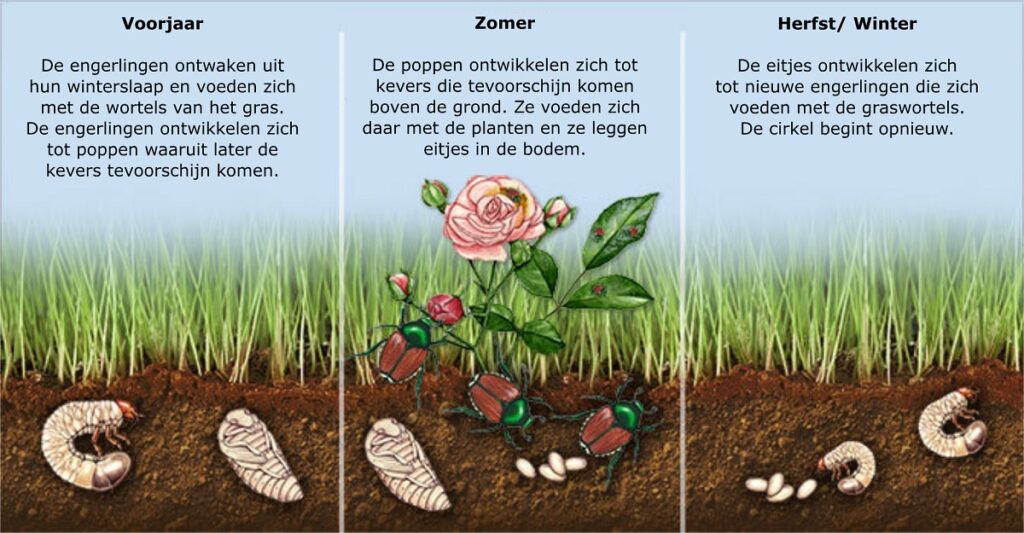Taxuskever

De Taxuskever Otiorhynchus sulcatus
De Taxuskever is afkomstig van de Snuitkever Familie. Deze keversoort is waargenomen in veel delen van de wereld, waaronder ook in Nederland. Hij is te herkennen aan zijn kenmerkende lange snuit en voelsprieten. Met zijn bruinzwarte kleur en gevlekte schild is hij goed te identificeren. Doorgaans hebben hebben ze een afmeting van 8-11 millimeter.
De levenscyclus van een Taxuskever
In tegenstelling tot de Meikever en Junikever kan de Taxuskever niet vliegen. Het schild op hun rug is vergroeid met het lichaam en de lange antennes hebben in het midden een lichte knik. Deze kever is s nachts actief en verplaatst zich door te lopen. Als je op zoek bent naar een Taxuskever, dan kun je het best onder plantenpotten, terrassen en andere donkere plekken kijken. In Europa is de Taxuskever als kever vanaf mei te vinden. Een volwassen Taxuskever is altijd een vrouwtje en deze blijft doorgaans 6 tot 8 maanden in leven. Wel moet hier worden bijgezegd, dat ze bij een middle winter langer kunnen leven. Er zijn gevallen bekend waarbij het vrouwtje meerdere jaren overleeft, maar zoals geschreven is dit sterk afhankelijk van de temperatuur. De Taxuskever doorloopt vier levensfases, hij begint als eitje, waaruit een larve (engerling) voortkomt, vervolgens komen ze in het pop-stadium, waarna ze uiteindelijk een volwassen kever worden.
Hoe plant de Taxuskever zich voort
De ontwikkeling van de Taxuskever varieert sterk en is in grote mate afhankelijk van de temperatuur. Een te hoge, of te lage temperatuur, vertraagd het voortplantingsproces. Daarnaast is een opvallende eigenschap van de Taxuskever dat de populatie volledig uit vrouwtjes bestaat. Deze vrouwtjes planten zich unisexueel voort, ze hebben dus geen mannetje nodig voor dit proces. De vrouwtjes leggen zolang ze leven eitjes, per keer tussen de 500 en 1000. Afhankelijk van de temperatuur doen ze dit elke 20 – 40 dagen. De perfecte temperatuur voor de Taxuskever om zich voor te planten ligt rond de twintig graden. Daarnaast is een hoge bodemvochtigheid goed voor de ontwikkeling. Indien het kouder is dan tien graden, of warmer dan dertig graden stoppen ze met het leggen van eieren.
In ideale omstandigheden kan een ontwikkeling van ei tot volwassen Taxuskever plaatsvinden in vier maanden. Maar het kan in een koud klimaat soms wel tot acht maanden in beslag nemen. Er wordt in het laatste geval overwinterd, wat de ontwikkelingssnelheid remt.

Schadebeeld door de Taxuskever
Het schadebeeld van de Taxuskever ontstaat door zowel de larven als de kever zelf. Deze larven worden in de volksmond ook wel engerlingen genoemd. Deze voeden zich in het eerste stadium van hun leven met kleine wortels van de beplanting. In dit eerste stadium zal bijvoorbeeld het gras nog niet veel schade ondervinden van de Engerlingen. Maar in het tweede stadium van het larve stadium beginnen ze aan grote wortels van het gras te eten. Door dit verloop wordt de plaag vaak pas in een laat stadium opgemerkt. Naast de schade die ontstaat door de larven, kunnen de Taxuskever ook zelf schade aanbrengen. Ze zijn alleen s nachts actief en nemen happen uit gewassen. Dit hoeft niet direct problemen op te leveren maar geeft natuurlijk wel een lelijk beeld. Indien de kevers in grote getale aanwezig zijn, dan kunnen ze een sierteelt volledig verwoesten.
Tot slot kan er zogenaamde secundaire schade ontstaan door het toedoen van vogels en andere zoogdieren, deze graven naar de larven in het gras waardoor natuurlijk de nodige schade kan ontstaan.
Krijg tot 10% korting op bestrijders bij onze partner Biobestrijding
"Laat de natuur zich herstellen"

